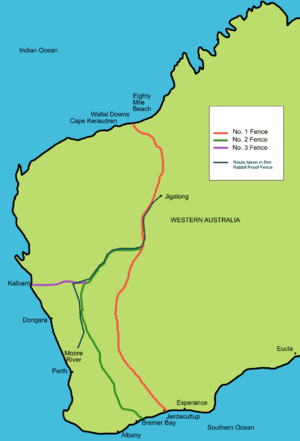Rabbit-Proof Fence (movie) facts for kids
Quick facts for kids Rabbit-Proof Fence |
|
|---|---|

Map of the rabbit-proof fence showing the trip from Moore River to Jigalong.
|
|
| Directed by | Phillip Noyce |
| Produced by | Phillip Noyce Christine Olsen John Winter |
| Screenplay by | Christine Olsen |
| Starring | Everlyn Sampi Kenneth Branagh David Gulpilil |
| Music by | Peter Gabriel |
| Cinematography | Christopher Doyle |
| Editing by | Veronika Jenet John Scott |
| Studio | Rumbalara Films Olsen Levy Showtime Australia |
| Distributed by | Becker Entertainment |
| Release date(s) | 4 February 2002 |
| Running time | 93 minutes |
| Country | Australia |
| Language | Western Desert language English |
| Budget | USD$6 million |
| Money made | USD$16.2 million |
Rabbit-Proof Fence is an Australian drama movie from 2002. It was directed by Phillip Noyce. The film is based on a true story from the book Follow the Rabbit-Proof Fence by Doris Pilkington Garimara. It tells the amazing journey of three young Aboriginal girls. These girls, Molly, Daisy Kadibil, and Grace, were taken from their families in 1931. They were sent to a place called the Moore River Native Settlement. This settlement was far from their home in Jigalong. The movie shows their brave nine-week walk. They followed the long rabbit-proof fence to find their way back home.
In 2005, the British Film Institute listed Rabbit-Proof Fence as one of the 50 films everyone should see by the age of 14.
Contents
About the Movie
Rabbit-Proof Fence is a powerful film. It shows a difficult time in Australian history. The movie focuses on three young Aboriginal girls. They were part of a group known as the "Stolen Generations." This name refers to children of Aboriginal and Torres Strait Islander descent. They were removed from their families by Australian government policies. These policies lasted from the early 1900s to the 1970s.
The True Story
The film is based on the real experiences of Molly Craig, Daisy Kadibil, and Grace. In 1931, these girls were taken from their community. They lived in Jigalong, a remote area. They were moved to the Moore River Native Settlement. This settlement was over 1,500 kilometers (930 miles) away. It was a place where Aboriginal children were sent. The idea was to teach them European ways of life.
The Great Escape
Molly, Daisy, and Grace did not want to stay at the settlement. They missed their families and their home. So, they decided to run away. Their plan was to walk all the way back to Jigalong. They knew about the rabbit-proof fence. This fence was built across Western Australia to keep rabbits out of farmland. It was one of the longest fences in the world. The girls used it as a guide. They knew if they followed the fence north, it would lead them close to their home.
The Long Journey
The girls walked for nine weeks. They faced many challenges during their journey. They had to find food and water in the harsh Australian Outback. They also had to avoid being caught. White law enforcement officers and an Aboriginal tracker were looking for them. The film shows their courage and determination. It highlights their strong connection to their family and land.
Who Made the Film?
The movie was directed by Phillip Noyce. The story was written by Christine Olsen. It was based on the book by Doris Pilkington Garimara. She is Molly Craig's daughter. This means the story comes directly from the family's experiences. The music for the film was created by Peter Gabriel.
Why This Film Is Important
Rabbit-Proof Fence helps people understand a sad part of Australia's past. It shows the strength and resilience of the Aboriginal people. The film reminds us how important family and home are. It also encourages us to learn about history. This helps us understand different cultures better. The movie has won awards and is seen as a very important Australian film.
Images for kids
-
Map of the rabbit-proof fence showing the trip from Moore River to Jigalong
See also
 In Spanish: Rabbit-Proof Fence para niños
In Spanish: Rabbit-Proof Fence para niños


